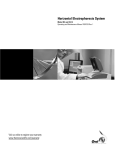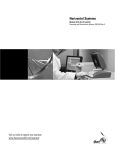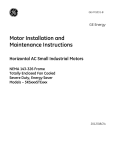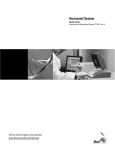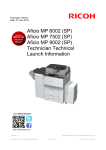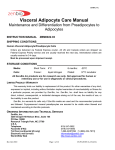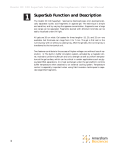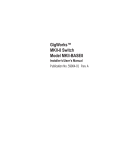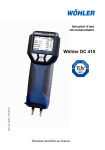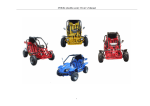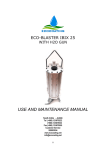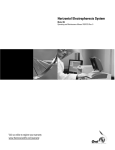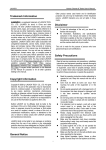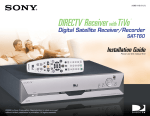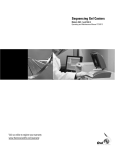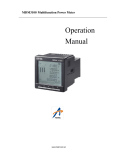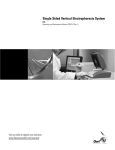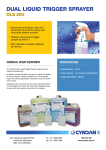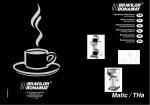Download A1, A2, A3-1, A5, and A6 Horizontal
Transcript
Horizontal Systems Models A1, A2, A3-1, A5, and M6 Operating and Maintenance Manual 7007301 Rev. 0 Visit us online to register your warranty www.thermoscientific.com/warranty Preface A1, A2, A3-1 A6 A5 MANUAL NUMBER 7007301 0 -- 4/10/12 REV ECR/ECN DATE Thermo Scientific Transfer to Marietta (was 3/2005) ccs DESCRIPTION By Horizontal Systems i Preface Important Read this instruction manual. Failure to read, understand and follow the instructions in this manual may result in damage to the unit, injury to operating personnel, and poor equipment performance. s Caution All internal adjustments and maintenance must be performed by qualified service personnel. s Warning To avoid the risk of personal shock, always disconnect the gel box from the power supply. Further, the power supply must be equipped with a shutdown-on-disconnect circuit. Do not move the unit unless the power source to the unit has been disconnected. s Statement of Proper Use: Use this product only for its intended purpose as described in this manual. Do not use this product if the power leads are damaged or if any of its surfaces are cracked. Running conditions for this unit should not exceed the name plate readings found on the lower buffer chamber. This Owl System is designed to meet IEC 1010-1 safety standards (IEC 1010-1 is an internationally accepted electrical safety standard for laboratory instruments). Material in this manual is for information purposes only. The contents and the product it describes are subject to change without notice. Thermo Fisher Scientific makes no representations or warranties with respect to this manual. In no event shall Thermo be held liable for any damages, direct or incidental, arising out of or related to the use of this manual. ©2012 Thermo Fisher Scientific. All rights reserved. ii Horizontal Systems Thermo Scientific Preface Important operating and/or maintenance instructions. Read the accompanying text carefully. Potential electrical hazards. Only qualified persons should perform procedures associated with this symbol. Equipment being maintained or serviced must be turned off and locked off to prevent possible injury. Hot surface(s) present which may cause burns to unprotected skin, or to materials which may be damaged by elevated temperatures. Marking of electrical and electronic equipment, which applies to electrical and electronic equipment falling under the Directive 2002/96/EC (WEEE) and the equipment that has been put on the market after 13 August 2005. This product is required to comply with the European Union’s Waste Electrical & Electronic Equipment (WEEE) Directive 2002/96/EC. It is marked with the WEEE symbol. Thermo Fisher Scientific has contracted with one or more recycling/disposal companies in each EU Member State European Country, and this product should be disposed of or recycled through them. Further information on Thermo’s compliance with this directive, the recyclers in your country and information on Thermo products will be available at www.thermofisher.com. 4 Always use the proper protective equipment (clothing, gloves, goggles, etc.) 4 Always dissipate extreme cold or heat and wear protective clothing. 4 Always follow good hygiene practices. 4 Each individual is responsible for his or her own safety. Thermo Scientific Horizontal Systems iii Preface Do You Need Information or Assistance on Thermo Scientific Products? If you do, please contact us 8:00 a.m. to 6:00 p.m. (Eastern Time) at: 1-740-373-4763 1-800-438-4851 1-877-213-8051 http://www.thermoscientific.com [email protected] www.unitylabservices.com Direct Toll Free, U.S. and Canada FAX Internet Worldwide Web Home Page Tech Support Email Address Certified Service Web Page Our Sales Support staff can provide information on pricing and give you quotations. We can take your order and provide delivery information on major equipment items or make arrangements to have your local sales representative contact you. Our products are listed on the Internet and we can be contacted through our Internet home page. Our Service Support staff can supply technical information about proper setup, operation or troubleshooting of your equipment. We can fill your needs for spare or replacement parts or provide you with on-site service. We can also provide you with a quotation on our Extended Warranty for your Thermo Scientific products. Whatever Thermo Scientific products you need or use, we will be happy to discuss your applications. If you are experiencing technical problems, working together, we will help you locate the problem and, chances are, correct it yourself...over the telephone without a service call. When more extensive service is necessary, we will assist you with direct factory trained technicians or a qualified service organization for on-the-spot repair. If your service need is covered by the warranty, we will arrange for the unit to be repaired at our expense and to your satisfaction. Regardless of your needs, our professional telephone technicians are available to assist you Monday through Friday from 8:00 a.m. to 6:00 p.m. Eastern Time. Please contact us by telephone or fax. If you wish to write, our mailing address is: Thermo Fisher Scientific 401 Millcreek Road, Box 649 Marietta, OH 45750 International customers, please contact your local Thermo Scientific distributor. iv Horizontal Systems Thermo Scientific Table of Contents Thermo Scientific Section 1 General Information . . . . . . . . . . . . . . . . . . . . . . . . . . . . . . . . . . . . . . . . . .1-1 Unpack and Check Your Order . . . . . . . . . . . . . . . . . . . . . . . . . . . . .1-2 Section 2 Setting Up . . . . . . . . . . . . . . . . . . . . . . . . . . . . . . . . . . . . . . . . . . . . . . . . . . .2-1 Section 3 Using the System . . . . . . . . . . . . . . . . . . . . . . . . . . . . . . . . . . . . . . . . . . . . .3-1 Model A5 Self- Recirculation System . . . . . . . . . . . . . . . . . . . . . . . . .3-2 Section 4 Finishing Up . . . . . . . . . . . . . . . . . . . . . . . . . . . . . . . . . . . . . . . . . . . . . . . . .4-1 Section 5 Technical Tips . . . . . . . . . . . . . . . . . . . . . . . . . . . . . . . . . . . . . . . . . . . . . . .5-1 Section 6 Troubleshooting . . . . . . . . . . . . . . . . . . . . . . . . . . . . . . . . . . . . . . . . . . . . . .6-1 Section 7 Care and Cleaning . . . . . . . . . . . . . . . . . . . . . . . . . . . . . . . . . . . . . . . . . . . .7-1 Section 8 Optional Equipment . . . . . . . . . . . . . . . . . . . . . . . . . . . . . . . . . . . . . . . . . . .8-1 Replacement Parts . . . . . . . . . . . . . . . . . . . . . . . . . . . . . . . . . . . . . . .8-2 Comb Options . . . . . . . . . . . . . . . . . . . . . . . . . . . . . . . . . . . . . . . . . .8-4 Horizontal Systems v Section 1 General Information The Model A1 horizontal large system has the smallest footprint of the large format device, giving you a space saving device for your extended runs. This system is ideal for detailed RNA/DNA analysis. The unit runs from 8 to 96 samples on one gel. A wall comb is available for running shorter gels and conserving agarose. A programmable power inverter may be used for field reversal electrophoresis. The Model A2 horizontal large system is a simple, convenient and fast system for detailed DNA/RNA analysis on multiple samples. This system offers the widest variety of comb options and when used with a wall comb you can cast varying length gels to conserve agarose. The Model A3-1 horizontal wide system can run from 25 to 600 samples on one gel. The gel can be cast in varying lengths to help conserve agarose when fewer samples need to be run utilizing a wall comb. This unit comes with built in buffer exchange ports to allow for buffer recirculation on extended runs, if needed. The large number of comb slots gives you sample and resolving distance flexibility. The Model A6 horizontal wide system offers a simple, convenient and fast method for screening multiple samples on a single agarose gel. 25 to 500 samples can be run simultaneously on one gel; producing clear, tight banding patterns with no “smiling”. The Model A5 recirculation system offers convenience and versatility. The A5 recirculation system prevents formation of pH and ionic gradients for high resolution and uniform reproducible results. The A5 is ideal for long runs, multiple sample sets or RNA gels. This unit delivers clear results for samples run over long time periods. It also eliminates uneven migration, band distortion or disassociation of pH dependent glyoxylated RNA molecules that can result when ionic depletion occurs. Because the recirculation system is built right into the buffer chamber, no external pumps, tubing or stir bars are required. The models listed above incorporate the end gate gel casting system. The UVT gel tray incorporates gasketed end gates which provides a leakproof seal without tape. Built in leveling ensures the casting of flat, uniformly thick gels. Sample loading is greatly enhanced using micro well pipette format combs (and a multichannel pipette) engineered specifically for use with this system. Using these combs and a multichannel pipette, samples may be loaded directly from a 96-well plate, 8 or 12 at a time. Sample loading with a multichannel pipette speeds up transfer and reduces chance of sample order error. Comb slots on the UVT gel tray are positioned so that you can run multiple sample sets of equal distances simultaneously. Thermo Scientific Horizontal Systems 1-1 Section 1 General Information Unpack and Check Your Order Before starting, unpack the unit and inventory your order. If any parts are missing, contact Technical Services within 7 days of purchase. SuperSafe™ Lid Power Supply Lead (2) End Gate (2) UVT Gel Tray Buffer Chamber Gasket (2) Leveling Screws (2) Leveling Base Combs (3) Bubble Level Figure 1-1. A1 and A2 Exploded Parts Diagram A1 & A2 Parts List • Buffer Chamber with Three Point Leveling Base • Combs: (3) 12, 16, and 20 well, 1.5mm Thick • Super Safe™ Lid with attached Power Supply Leads (2) • UV Transmissible (UVT) gel tray wth Gasketed End Gates (2) • Bubble Level See Section 8 for replacement parts or optional combs. Specifications and Recommended Running Conditions 1-2 Horizontal Systems Model A1 A2 Gel Size (W x L in cm.) 13 x 25 20 x 25 Buffer Capacity 1.6L 2.3L Time Requirements (hours) 1-4 1-4 Thermo Scientific Section 1 General Information Unpack and Check Your Order (cont.) Power Supply Lead (2) SuperSafe™ Lid End Gate (2) Gasket (2) UVT Gel Tray Buffer Chamber Built In Buffer Exchange Ports Leveling Screws (2) Comb (4) Leveling Base Bubble Level Figure 1-2. A3-1 Exploded Parts Diagram A3-1 Parts List • Buffer Chamber with Three Point Leveling Base • (4) Combs: • (2) 25 well • (2) 50 well, 1.5mm Thick • Super Safe™ Lid with attached Power Supply Leads (2) • UV Transmissible (UVT) gel tray with Gasketed End Gates (2) • Built in Buffer Exchange Ports • Bubble Level See Section 8 for replacement parts or optional combs. Model . . . . . . . . . . . . . . . . . . . . . . . . . . . . . . . .A3-1 Gel Size (W x L in cm.) . . . . . . . . . . . . . . . .23 x 40 Buffer Capacity . . . . . . . . . . . . . . . . . . . . . . . . .4.5L Voltage Requirements (V) . . . . . . . . . . . . . . .20-250 Thermo Scientific Horizontal Systems 1-3 Section 1 General Information Unpack and Check Your Order (cont.) Power Supply Lead (2) SuperSafe™ Lid UVT Gel Tray End Gate (2) Buffer Chamber Gasket (2) Leveling Screw (2) Leveling Base Comb (4) Bubble Level Figure 1-3. A6 Exploded Parts Diagram A6 Parts List • Buffer Chamber with Three Point Leveling Base • (4) Combs • (2) 25 well • (2) 50 well, 1.5mm Thick • Super Safe™ Lid with attached Power Supply Leads (2) • UV Transmissible (UVT) gel tray wth Gasketed End Gates (2) • Bubble Level See Section 8 for replacement parts or optional combs. Specifications and Recommended Running Conditions Gel Size (W x L in cm.) . . . . . . . . . . . . . . . .23 x 25 Buffer Capacity . . . . . . . . . . . . . . . . . . . . . . .3000ml Voltage Requirements (V) . . . . . . . . . . . . . . .20-250 1-4 Horizontal Systems Thermo Scientific Section 1 General Information Unpack and Check Your Order (cont.) Power Supply Lead (2) SuperSafe™ Lid End Gate (2) UVT Gel Tray Buffer Chamber Gasket (2) Leveling Screw (2) Comb (3) Leveling Base Conduit Tube Bubble Level Figure 1-4. A5 Exploded Parts Diagram A5 Parts List • Buffer Chamber with Three Point Leveling Base • (3) Combs 16, 24, & 36 well, 1.5mm Thick • Super Safe™ Lid with attached Power Supply Leads (2) • UV Transmissible (UVT) gel tray wth Gasketed End Gates (2) • Bubble Level See Section 8 for replacement parts or optional combs. Model A5 Gel Size (W x L in cm.) . . . . . . . . . . . . . . . .20 x 25 Buffer Capacity . . . . . . . . . . . . . . . . . . . . . . . . .2.0L Voltage Requirements (V) . . . . . . . . . . . . . . .20-250 Thermo Scientific Horizontal Systems 1-5 Section 2 Setting Up 1. Remove the SuperSafe™ lid from the buffer chamber. The SuperSafe™ lid is attached to the back of the unit at the junction of the lids attached power supply leads to the banana plugs located on the unit. To remove, hold the front of the buffer chamber with one hand and pull the lid off; sliding off evenly by holding the center of the back of the lid. 2. For shipping and convenient storage, the UVT gel tray is packaged inside the unit with the gasketed end gates in position upon arrival. Lift the UVT gel tray out of the buffer chamber. 3. To cast gels, place the UVT gel tray into the chamber making sure the gel tray rests level and centered on the platform. Slide the gasketed end gates into the outermost grooves on either side of the gel tray. The end gates should be inserted tightly into Figure 2-1. End Gates the grooves with the gasket side facing out. 4. Leveling the unit - Larger size gels make the need to cast and run a level gel is very important for consistent reproducible results. Level the unit using the thumbscrews on each side of the front of the unit by slowly turning one thumbscrew at a time and lining up the bubble in the level with the center circle (the rear screw is for stability only). 5. Preparing the gel - Using electrophoresis grade agarose and compatible electrophoresis buffer, the gel may be prepared in various ways. The percentage of agarose and the electrophoretic buffer used is determined by the size of the samples to be separated and further recovery of the samples (see Table 5-1. Figure 2-2. Pour The agarose and buffer are mixed and heated over a heat source, in a microwave oven, or in an autoclave until the agarose is completely dissolved. The prepared gel then must be cooled to below 60°C before casting to avoid warping the UVT gel tray, due to excessive heat. If numerous gels are to be run in one day, a large volume of gel may be prepared and placed in a covered bottle stored between 40-60°C in a water bath. This provides a ready gel supply in a warm liquid form that will solidify quickly when gels are cast. For further tips on sample preparation and visualization, see Table 5-1. Thermo Scientific Horizontal Systems 2-1 Section 2 Setting Up 6. Pour or pipette the correct amount (see Table 5-2) of warm agarose (<60°C) onto the UVT gel tray that has been placed into position in the gel box. Immediately after pouring, insert the desired comb or combs into the comb slots to form the sample wells. If only a small portion of gel is required for proper sample separation, multiple combs may be used to run 2, 3, Figure 2-3. End Gates 4, 5 or 10 sets (depending on model) of equal distance samples simultaneously expanding the number of samples per gel that may be run. To conserve agarose, a wall comb may also be used to divide and use a smaller portion of the length of the gel tray. If a wall comb is used, pipette a bead of agarose along the bottom and side edges of the wall comb once it has been placed in the tray to seal the combs edges to the trays bottom and sides. Once this bead is solidified, the cooled gel may be poured as described. Alternately, regular tape cut slightly longer then the comb can be placed flat along the combs surface and the comb angled into place in the gel tray. Extra tape is then placed on the outside of the comb in the excess tray area to reinforce the corners. Allow the gel to solidify completely. Migration Distance • Run one sample set on a gel in each tray. • Run two sample sets on a gel of equal length (comb slots) in each tray. • Run three sample sets on a gel of equal length samples (comb slots) in each tray. Run Length 1X Run Length 2X • 2-2 Horizontal Systems Run Length 3X Run four sample sets on a gel Run Length 4X of equal length samples (comb slots) in each tray and so on Figure 2-4. Migration Distance up to 12 rows. Thermo Scientific Section 2 Setting Up Migration Distance (continued) The following charts show the specific tray options for each model. One comb for a 23.2 run length Two combs for two 11.4cm run lengths Three combs for three 7.5cm run lengths Four combs for four 5.5cm run lengths Figure 2-5. A1, A2 and A5 Migration Distance Thermo Scientific Horizontal Systems 2-3 Section 2 Setting Up One comb for a 39.4cm run length Two combs for two 19.5cm run lengths Three combs for three 12.9cm run lengths Four combs for four 9.6cm run lengths Six combs for six 6.3 run lengths 12 combs for twelve 3cm run lengths Figure 2-6. A3-1 Migration Distance One comb for a 23.2cm run length Two combs for two 11.4cm run lengths Three combs for three 7.5cm run lengths Four combs for four 5.5cm run lengths Five combs for five 4.4 run lengths Ten combs for ten 2cm run lengths Figure 2-7. A6 Migration Distance 2-4 Horizontal Systems Thermo Scientific Section 3 Using the System 1. Place the gel tray in the buffer chamber, lift the end gates out of the gel tray. This running position exposes the open ends of the agarose to the buffer. 2. Pour enough compatible running buffer into the unit to fill both buffer chambers and completely cover and submerge the gel. Correct buffer level is clearly marked on the units side wall as “FILL LINE”. See Recommended Running Conditions (Section 1) for approximate buffer volumes needed for your unit. Too little buffer may cause the gel to dry out during the run, while excess buffer may decrease DNA mobility and cause band distortion. 3. Carefully remove the comb (or combs) by tapping lightly to loosen, and slowly lifting straight up out of the gel tray to avoid damage to the wells. 4. Load prepared samples into the wells. Samples should be mixed with a sample loading buffer; giving weight to the samples so that they drop evenly into the wells and containing tracking dyes to monitor the gel run. See available comb section for approximate well volumes (Section 8 - Comb Options). 5. Carefully slide the SuperSafe™ lid with attached power supply leads onto the unit. This will connect the power cords to the banana plug electrodes and complete the circuit. Plug the other end of the power supply leads into an appropriate power supply. 6. Turn on power supply. Refer to Table 4-1 for running conditions. Carefully monitor the gel run to avoid samples running into the path of another set of samples. Thermo Scientific Horizontal Systems 3-1 Section 3 Using the System Model A5 SelfRecirculation System The Model A5 Self-Recirculation System has a unique built-in recirculating system designed to self recirculate buffer. Bubbles are collected at the cathode end of the unit and shunted through a conduit tube from the cathode end of the buffer chamber to the anode end of the buffer chamber. The bubbles displace buffer creating an effective recirculation within the chamber. The self recirculating system reduces formation of pH gradients for high resolution and uniform, reproducible results. The self-contained recirculation system requires no external pumps, tubing or stir bars. As shown in the diagram, a trap at the cathode end of the buffer chamber (1) collects the hydrogen bubbles produced at the electrode during electrophoresis. The bubbles are then shunted into a conduit tube (2) to the anode end of the chamber. This flow of bubbles displaces buffer (3) to create an internal recirculation system. See page 10 and 24 for Owl Self Recirculating devices. See Section 8 - Buffer Exchange Port Option, available for A1, A2 and A6 models. 3-2 Horizontal Systems Thermo Scientific Section 4 Finishing Up 1. When the gel run is complete and tracking dye has migrated as far through the gel as desired, or to the end of the gel, turn off the power supply and slide off the SuperSafe™ lid to disconnect from the power source. Carefully remove the tray containing the gel (wear gloves if ethidium bromide is present). The UV Transmissible (UVT) gel tray makes visualization and photography with a UV light source easy without the need to remove the gel from the tray. 2. The buffer chamber, SuperSafe™ lid, UVT gel tray and combs should be rinsed under warm running water after each use. An RNase/DNase decontaminate may be used. Caution This electrophoresis system must never be autoclaved, baked, or microwaved! s Table 4-1. Specifications and Recommended Running Conditions Thermo Scientific Model A1 A2 A3-1 A5 A6 Gel Size (W x L in) 13 x 25 20 x 25 23 x 40 20 x 25 23 x 25 Buffer Capacity 1.6L 2.3L 4.5L 2.0L 3000ml Voltage Requirements (V) 20-250 20-250 20-250 20-250 20-250 Time Requirements (hours) 1-4 1-4 1-6 1-6 1-4 Horizontal Systems 4-1 Section 5 Technical Tips Running a Standard Ladder It is recommended to always run a sample lane of a known “standard ladder” or “marker” to determine concentration and size of separated fragments after the gel run, and to aid in photodocumentation and analysis. Migration patterns and fragment sizes for commonly used DNA molecular weight markers are shown in this figure. - 23,130 - 9,416 - 6,557 - 4,361 - 2,322 - 2,027 Figure 5-1. Sample Lane Loading Samples It is sometimes easier to load the sample wells dry before placing buffer into the buffer chamber. After the gel solidifies, if cast within the buffer chamber, remove the gel tray from the buffer chamber and place the tray on the lab bench. Carefully remove the sample combs by tapping and lifting straight up. Samples mixed with loading buffer that does not contain dye may be easier to load dry, especially in larger gel units to avoid cross contamination. After loading all sample lanes, place the gel tray into the buffer chamber in the running position with the gel edges facing out toward the buffer chambers with the gasketed end gates removed and slowly fill the chamber with buffer. Thermo Scientific Horizontal Systems 5-1 Section 5 Technical Tips Comb Options Standard 1.0mm and 1.5mm thickness: for all models. Combs are hand fabricated for high quality precision in low volumes. Each comb has an acrylic spine with Lexan® teeth. Standard Preparative Preparative combs are manufactured with an acrylic spine and Lexan® teeth. Used for extremely large samples. Preparative Multi Load Comb Multi-Load Comb Figure 5-2. Comb Options For use with 8-12 channel pipettes. These unique combs are designed to allow accurate easy loading from a 96 well plate. Custom Combs Calll Technical Services for more information. Wall Comb The wall comb is used in your existing U.V. Transmissible (UVT) gel tray to allow the ability to cast smaller gels using the existing gel Wall Comb tray and the comb slots. There are various ways to use the wall comb Figure 5-3. Wall Comb Option to ensure a leak proof seal. The following two are the fastest and easiest. 5-2 Horizontal Systems Thermo Scientific Section 5 Technical Tips Wall Comb (continued) Tape Method Using casting tape, transparent tape, or masking tape, cut a piece long enough to cover the full length of the wall comb with about 1/2" overhang at each end. Half the width of the tape should be free. Firmly press the tape all along the comb leaving the three open edges loose. Place the comb with tape into the gel tray at the desired comb slot position. The taped side of the comb should be facing away from where the gel will be cast. Angle the comb as it is being placed into the comb slot so the loose taped edge is free. Once positioned into the gel tray, firmly press the tape to the bottom and sides of the gel tray to form a leakproof seal. Small extra pieces of tape may be added to the corners afterwards to reinforce the edges. Add cooled (<60°), slightly thickened agarose to the gel tray and allow to solidify completely. To remove comb, gently remove excess tape and loosen tape from the bottom and sides of the gel tray. Carefully pull comb straight up and out of the comb slot. Note The edge of the gel may appear irregular, once submerged in running buffer, the gel run will be unaffected. s Agarose Plug Method Place the wall comb into the desired comb slot. Prepare agarose as usual and remove about 3ml to a test tube. Allow this aliquot to cool and thicken enough to make a thin partially solid worm of agarose. Using a Pasteur pipette or other transfer device, gently place a small stream of agarose all along the three comb edges at the bottom of the gel tray and sides to form a leakproof seal. Allow “plug” to solidify completely checking that all exposed areas are filled in with agarose. Next, add cooled agarose (<60°) to the gel tray. After the gel is completely solidified; rock the comb back and forth slightly to loosen it when removing to avoid damage to the gel. Adding running buffer to the buffer chamber prior to removing comb(s) may make the comb removal easier. Thermo Scientific Horizontal Systems 5-3 Section 5 Technical Tips Helpful Tips • Cooling the agarose slightly more than usual will help eliminate leaking because the gel thickens as it solidifies and is less likely to leak. To avoid visible solids due to uneven cooling, gently swirl the agarose. Exact temperature of the agarose depends on the type used, but the gel should be thickened yet still evenly liquid so it is pourable and consistent. • Gels of higher concentrations (>0.5%) are also easier to work with, especially when using the agarose plug method. Micro Well Format Combs Micro well format combs, available with many Owl horizontal and sequencing devices, are meant to be Micro Well Format 1X used in conjunction with an 8- or 12channel pipette. The pipette is manufactured to be used with a 96 well (8 wells wide x 12 wells long) multichannel plate. The key here is the Micro Well Format 2X constant distance of 9mm between the Figure 5-4. Micro Well Combs center of each well in the multichannel plate. The multichannel pipette is set up so that the pipette tips are exactly 9mm apart, and a researcher can take up 8 (or 12) samples simultaneously from the plate. To be able to load these samples simultaneously onto a gel, the “center to center” distance between sample wells in the gel must be exactly 9mm. The micro well format comb that would give this exact distance would be a 1x micro well format comb. However, the ability to space wells exactly 9mm apart is dependent on the total width of the gel and the number of sample wells that the researcher wants in the gel. There are four options that fit the use of a 9mm “center to center” pipette tip format. The 9mm spacing represents a 1x option micro well format. By decreasing the center to center distance in factors of 9mm, one can fit more samples in a given amount of space with the ability to use the same micro well format pipette. The 2x is 9 divided by 2, the 3x is 9 divided by 3 and the 4x is 9 divided by 4. 5-4 Horizontal Systems Thermo Scientific Section 5 Technical Tips Micro Well Format Combs (continued) Therefore, it is possible to have a greater number of teeth in a comb and maintain the use of the multichannel pipette, by having the multichannel pipette fill every other well rather than every well. This type of multichannel pipette format comb is called a 2x multichannel pipette format comb. For example, the 50 tooth comb for the A6 device has “center to center” distances between teeth of 4.5cm. This means that a researcher would load lanes 1, 3, 5, 7, 9, 11, 13, and 15 with the first pass of the pipette and 2, 4, 6, 8, 10, 12, 14 and 16 with the second pass, and so on until all of the lanes are filled. When using an 8 (or 12) channel pipette, the number of sample wells that can be filled must be a multiple of 8 (or 12). A 1st Loading 25 well micro well format comb would have one extra sample and a 50 well micro well format comb would have 2 extra 2nd Loading samples, which a researcher could fill with a single channel pipette, and is generally used for standards. Micro Well Format 1X Micro Well Format 2X Figure 5-5. Loading Micro Wells Why Recirculate Buffer? During electrophoresis, gradual ionic depletion of the running buffer forms an ionic and pH gradient across the system (acetate and phosphate buffers are especially prone to ionic depletion). Such gradients can cause uneven migration and banding patterns or cause pH-dependent glyoxylated RNA molecules to disassociate. Buffer recirculation ensures uniform ionic strength throughout the system. Thermo Scientific Horizontal Systems 5-5 Section 5 Technical Tips Why Recirculate Buffer? (continued) Comparison of buffer pH with and without recirculation during agarose gel electrophoresis 50ng samples of HindIII digested DNA were run on duplicate gels, with and without buffer recirculation. pH measurements were taken at the anode and cathode ends at various time intervals and plotted against time. Running condition: 1% agarose gel in 10mM NaH2PO4, pH 7.0, 114V, constant voltage. Figure 5-6. Comparison Sample Well / Comb Configuration Hg = height of gel used Hw = well height Hs = height of well used for sample volume How to determine well sample volume: There are two volumes to consider when determining the sample volume for a horizontal gel. 1) Gel volume, which is Width x Length x Gel Height and uses centimeters and 2) Sample volume which is Tooth Width x Comb Thickness x Apparent Well Height, and uses millimeters. Figure 5-7. Determine Volume 5-6 Horizontal Systems Thermo Scientific Section 5 Section title How to determine well sample volume (continued): Gel height is generally set to a height between 0.25 cm and 1.0 cm. Therefore, once you choose the height, the volume is the gel dimensions given in the catalog for each gel box (I.D.) times this height. Once the gel height (Hg) is chosen, the well volume and then the sample volume can be calculated. The well height (Hw) is 1.5 mm less then the gel height: Hw = Gel Height – 1.5 mm. Using the well height, the volume of the well is calculated: Vw = (Well Height) (Tooth width x comb thickness). The loading volume is a 0.75 safety factor applied to the well volume: Vs = (Vw) (.75) For Owl combs, there are two thicknesses, 1.0mm and 1.5mm. This is the depth. The width of the well is determined by the number of teeth. For a given gel box, as the number of teeth increase, the volume of each tooth decreases. Reagent Information There are various types of agarose commerically available that may be used. Besides standard ultra pure electrophoresis grade agarose, there are also numerous low melting point products for easy sample recovery, as well as speciality products formulated for specific uses to separate/recover very small or very large fragments etc. To visualize and photograph the samples after the gel run for a permanent record, the gel may be stained during or following the run with a variety of stains. The most common stain for DNA is ethidium bromide. Ethidium bromide may be added directly to the gel and running buffer to quickly and easily visualize and photograph the separated fragments following the gel run without the need for additonal staining. If this is not added, then following the gel run the gel may also be soaked in a concentrated ethidium bromide solution and rinsed for the same visualization. The ethidium bromide is added to both the gel (after heating) and the electrophoresis buffer at a concentration of 0.5μg/ml. Ethidium bromide is a potential carcinogen. Care in handling the powder and stock solution must be taken. Always wear gloves when handling the powder, solutions and all gels that contain any amount of ethidium bromide. Thermo Scientific Horizontal Systems 5-7 Section 5 Technical Tips Table 5-1. Mobility range of DNA in different percentage agarose gels Agarose % (w/v) Approximate range of separated DNA fragments (kb) 0.3 60 to 5 0.5 30 to 1 0.7 12 to 0.8 1.0 10 to 0.5 1.2 7 to 0.3 1.5 4 to 0.2 2.0 3 to 0.1 3.0 <0.1 It should be noted, an increased agarose % gives better separation of small fragments and also bands very close together that tend to be more difficult to separate, visualize and photograph. A specialty agarose product formulated to increase resolution of low molecular mass samples may also be used. Example: A good mid range gel percentage would be 0.7%, or 0.7g agarose in 100mls electrophoresis buffer (TBE or TAE), following heating and dissolving the agarose, 10μl of ethidium bromide stock solution (5mg/ml) is added. The gel would be run with compatible electrophoretic running buffer (1X TBE or 1X TAE) that also contained ethidium bromide 1 liter of the running buffer would contain 100μl of this 5mg/ml ethidium bromide stock solution. Preparation & Properties of TAE and TBE Electrophoresis Buffer Systems: These buffers are used because they both have a basic pH which gives the phosphate group of the DNA a net negative charge allowing migration of the DNA toward the positive anode in the electrophoresis chamber. TAE - Tris acetate with EDTA (40mM Tris base 40mM acetic acid,1mM EDTA) 50X stock solution, pH ~8.5 1X working solution 242g Tris base 40mM Tris acetate 57.1ml glacial acetic acid 1mM EDTA 18.61g Na2EDTA - 2H2O (MW 372.24) Distilled H2O to 1 liter final volume 5-8 Horizontal Systems Thermo Scientific Section 5 Technical Tips TBE - Tris borate with EDTA (89mM Tris base, 89mM boric acid, 2mM EDTA) 10X stock solution 1X working solution 108g Tris base 89mM Tris base 55g boric acid 89mM boric acid 7.44g Na2EDTA - 2H2O (MW 372.24) 2mM EDTA (or 40 ml 0.5 M EDTA, pH 8.0) Distilled H2O to 1 liter final volume Do not adjust pH Buffer Suggested Uses and Comments TAE Buffer Use when DNA is to be recovered For electrophoresis of large (>20kb) DNA Applications requiring high resolution Has low ionic strength and low buffering capacity recirculation may be necessary for long runs (>4hrs.) TBE Buffer For electrophoresis of small (<1kb) DNA Better resolution of small (<1kb) DNA Decreased DNA mobility High ionic strength and high buffering capacity no recirculation needed for extended run times TBE buffer reacts with the agarose making smaller pores and a tighter matrix. This reduces broadening of the DNA bands for sharper resolution. Thermo Scientific Horizontal Systems 5-9 Section 5 Technical Tips Ethidium Bromide Ethidium bromide is ideal for the flurometric detection of nucleic acids in gel electrophoresis. The addition of ethidium bromide to both the prepared gel and running buffer is a convenient way to monitor separation and keep a photographic log of gel runs. Ethidium Bromide is prepared as 10mg/ml in distilled water and used as a stock working solution of 5.0μg/ml in the electrophoresis buffer and gel. Mix ethidium bromide powder or tablet thoroughly into solution checking for any precipitate and store at room temperature protected from light. Amount of Agarose to prepare: Gel volume is determined by the following formula and may be adjusted according to need or preference: Table 5-2. Amount of Agarose gel width(cm) X gel length (cm) X gel thickness (cm) = ml of agarose Agarose Volume in ml per gel thickness in cm. Model # Gel size(cm) 0.25cm 0.5cm 0.75cm 1.0cm A1 13x25 81ml 163ml 244ml 325ml A2 20x25 125 250 375 500 A3-1 23x40 230 460 690 920 A5 20x25 125 250 375 500 A6 23x25 144 288 432 575 Agarose Gel Loading Buffer Samples are prepared and combined with gel loading buffer before being applied to the prepared gel. Sample buffer usually contains similar components to the running buffer, dyes for visibility, and glycerol to provide some weight to the samples. This increased sample density and color allows easy visualization of the samples and ensures samples load evenly into the wells and do not float out during loading. Dyes also migrate toward the anode end of the electrophoresis chamber at predictable rates allowing the gel run to be monitored. The most commonly used loading buffer is glycerol, bromophenol blue, and xylene cyanol. 5-10 Horizontal Systems Thermo Scientific Section 6 Thermo Scientific Troubleshooting Problem Solution Agarose leaks into chamber when casting the gel Check to see if the gasket is correctly seated in groove and even all the way around. Remove gasket and reseat by smoothing out gently with your thumb from one end to the other. Gasket material may have a tendency to absorb salts from the running buffer. After each use, rinse the end gates under warm running water to bring back spongelike consistence of the gasket material. Gaskets may eventually become brittle with frequent use. Contact Technical Services to purchase replacement gaskets. Check to make sure gasketed end gates have been placed with in UVT gel tray with gaskets facing out Bands seem to be running at an angle. Check to be sure that the unit is properly leveled for casting and running the gel by using the front thumbscrews on the base. Thumbscrews should be adjusted until the bubble in the level lines up with the levels center circle. Always center the gel tray holder on the platform and cool the agarose to below 60°C before pouring to avoid warping the UVT gel tray (s). Samples seem to be running unevenly in certain areas. Check that the platinum electrode wire is intact running flat and evenly across the outer corners and up the side to the junction of the banana plug area. This problem could also be caused by regular casting with very hot agarose gel (>60°C) which may damage the gel tray over time. Always cool the melted agarose to below 60°C before casting to avoid warping the UVT gel tray (s). Warping the UVT gel tray will cause all subsequent gels to be cast unevenly. Samples do not band sharply and appear diffuse in the gel. Gels should be allowed to solidify completely before running. For standard agarose, this would be about 30 minutes, if low melting point agarose is used, it may be necessary to completely solidify gels at a cooler temperature in the refrigerator or cold room. Gels should be submerged in 3-5mm of buffer to avoid gel dry out, but excess buffer >5mm can cause decreased DNA mobility and band distortion. Horizontal Systems 6-1 Section 6 Troubleshooting Problem Solution Bands are not sharp, clear, and even. Always follow the proper procedure for preparing the agarose product according to the manufacturers instructions. When preparing the agarose be sure all the agarose powder is in solution before heating. In general, add powdered agarose to distilled water and swirl to mix. Make sure all the powder is equally wet to ensure proper melting. Heat in a microwave oven, boiling water bath, or hot plate with occasional swirling to melt and mix completely. Cool agarose liquid to below 60° and cast. Note: High percentage gels may thicken and solidify rapidly and should be cast while still a liquid. Samples are not moving as expected through the gel, remaining in the wells, or diffusing into the gel. Check that a complete power circuit is achieved between the unit and the power supply. Platinum wire and banana plugs should be intact. To test, simply fill the unit with running buffer and attach to the power supply without a gel or gel tray in the unit. The platinum wires on both sides of the unit should produce small bubbles as the current passes through. If a complete circuit does not exist there will be few to no bubbles. Contact Technical Services to schedule a repair. Always make sure to allow the gel to solidify completely before moving the gel tray, unit, or removing the comb. To avoid damage to the sample wells, gently rock the comb back When the comb is removed and forth lightly to loosen, then slowly pull the comb straight from the gel, some sample up out of the gel tray. This rocking helps to avoid suction as wells are ripped and damaged. the comb is removed. Alternatively, once casting is complete, simply submerging the gel with running buffer will help loosen the comb. Using a higher percentage of agarose that forms a tighter gel matrix may remedy this problem as well. The volume of running buffer used to submerge the gel should only be between 3-5mm over the gel surface. Gel should be completely submerged to avoid the gel from drying The gel seems to run slower out, which can smear the bands and possibly melt the gel (s) under the usual running condidue to overheating. If excessive running buffer is added, the tions. mobility of the DNA decreases and band distortion may result. Excess buffer causes heat to build up and buffer condensation inside the unit may result. 6-2 Horizontal Systems Thermo Scientific Section 6 Troubleshooting Additional Sources for Reference Maniatis T., E. F. Fritsch and J. Sambrook. Molecular Cloning: A Laboratory Manual, Cold Spring Harbor Laboratory, Cold Spring Harbor, NY. Short Protocols in Molecular Biology, - A Compendium of Methods from Current Protocols in Molecular Biology, Edited by Fredrick M. Ausubel, et. al. Adams, D., and R. Ogden, Electrophoresis in Agarose and Acrylamide Gels, Methods in Enzymology, Vol. 152 (1987) Academic Press, Inc. Fotador, U.. Simultaneous Use of Standard and Low-Melting Agarose for the Separation and Isolation of DNA by Electrophoresis, BioTechniques, Vol. 10, No. 2, (1991) Boots, S. Gel Electrophoresis of DNA ; Analytical Chemistry, Vol. 61, No. 8, April 15, 1989 Thermo Scientific Horizontal Systems 6-3 Section 7 Care and Cleaning Caution Organic solvents cause acrylic to “craze” or crack. Clean all Owl acrylic systems with warm water and a mild detergent. Do not use ethanol or other organic solvents to clean Owl products. Do not autoclave, bake, or microwave your unit. Temperatures over 50°C can damage to the acrylic. s Note If an RNase free electrophoresis system is desired, there are various methods to rid the system of RNA contamination. For fast and easy decontamination, use RNase Away®*. Spray, wipe or soak labware with RNase Away, then wipe or rinse the surface clean; it instantly eliminates RNase. RNase Away eliminates the old methods that include treatment with 0.1% Diethyl Pyrocarbonate (DEPC) treated water and soaking in diluted bleach. DEPC is suspected to be a carcinogen and should be handled with care. This electrophoresis system should never be autoclaved, baked, or placed in a microwave. s To order RNase Away, contact Technical Services: Part Number Description 7000 250ml bottle 7002 475ml spray bottle 7003 1 liter bottle 7005 4 liter bottle *Rnase Away® is a registered trademark of Molecular BioProducts Thermo Scientific Horizontal Systems 7-1 Section 7 Care and Cleaning Care of Acrylic The following chemical compatibility chart is supplied for the convenience of our customers. Although acrylic is compatible with most solvents and solutions found in the biochemical laboratory, some solvents can cause substantial damage. Keep this chart handy to avoid harm to your apparatus by the use of an inappropriate solvent. Codes: S - Safe (no effect, except possibly some staining) A - Attacked (slight attack by, or absorption of, the liquid) (slight crazing or swelling, but acrylic has retained most of its strength) U - Unsatisfactory (softened, swollen, slowly dissolved) D - Dissolved (in seven days, or less) This list does not include all possible chemical incompatibilities and safe compounds. Acrylic products should be cleaned with warm water, a mild detergent such as Alconox™, and can also be exposed to a mild bleach solution (10:1). In addition, RNAse removal products are also safe for acrylic. 7-2 Horizontal Systems Thermo Scientific Section 7 Care and Cleaning Table 5-1. Chemical Compatibility for Acrylic-Based Products Chemical Code Chemical Code Chemical Code Acetic acid (5%) S Ethyl alcohol (50%) A Naptha S Acetic acid (Glacial) D Ethyl alcohol (95%) U Nitric acid (10%) S Acetic Anhydride A Ethylene dichloride D Nitric acid (40%) A Acetone D Ethylene glycol S Nitric acid concentrate U Ammonia S 2-Ethylhexyl Sebacate S Oleic acid S Ammonium Chloride (saturated) S Formaldehyde (40%) S Olive oil S Ammonium Hydroxide (10%) S Gasoline, regular, leaded S Phenol 5% solution U Hydroxide (10%) S Glycerine Heptane (commercial grade) S Soap solution (Ivory) S Ammonium Hydroxide concentrate S Hexane S Sodium carbonate (2%) S Aniline D Hydrochloric acid (10%) S Sodium carbonate (20%) S Benzene D Hydrochloric acid concentrate S Sodium chloride (10%) S Butyl Acetate D Hydrochloric acid (40%) U Sodium hydroxide (1%) S Calcium chloride (saturated) S Hydrogen peroxide (3% solution) S Sodium hydroxide (10%) S Carbon tetrachloride U Hydrogen peroxide (28% solution) U Sodium hydroxide (60%) S Chloroform D Isooctane S Sodium hydrochlorite (5%) S Chromic acid (40%) U Isopropyl alcohol (100%) A Sulfuric acid (3%) S Citric acid (10%) S Kerosene (no. 2 fuel oil) S Sulfuric acid (30%) S Cottonseed oil (edible) S Lacquer thinner D Sulfuric acid concentrate U Detergent Solution (heavy duty) S Methyl alcohol (50%) A Toluene D Diesel oil S Methyl alcohol (100%) U Trichloroethylene D Diethyl ether U Methyl Ethyl Ketone U Turpentine S Dimethyl formamide U Methylene chloride D Water (distilled) S Dioctyl phthalate A Mineral oil (white) S Xylene D Ethyl acetate D Thermo Scientific Horizontal Systems 7-3 Section 8 Optional Equipment Optional Multi-Load Tray and Combs Multiple sample loading configured for use with an 8 or 12 channel pipette is available by using the multi-load tray (A2-RL-12 and A2-RL-24) and combs (A2-RL-18D). Figure 8-1. Multi-Load Tray Buffer Exchange Port Option, for Models A1, A2, and A6 The buffer exchange port option is used to recirculate the buffer during extended gel runs. Recirculation is used to prevent buffer depletion of certain low ionic running buffers, for extended runs, multiple sample sets, or for RNA gels. If your unit has the buffer exchange port option, it will be fitted with two white Figure 8-2. Buffer Exchange Port Option buffer port terminals and will contain two separate port inserts packaged in a small plastic bag located inside the unit upon arrival. Ports are attached to a user supplied pump. How these work… The inserts are pushed into the attached ports on the side wall of the unit with the black O-ring side facing in. The insert will “snap” into place in the port in the “open” position and is ready to circulate buffer. Appropriate tubing is then connected to the small outer ringed ends of the ports for circulation using a separate recirculator or peristaltic pump. To close the port, which also releases the insert, you simply press the flat metal button and the insert detaches. The port is now in the “closed” position. Note Buffer may also be passed through a heat exchanger. s Thermo Scientific Horizontal Systems 8-1 Section 8 Optional Equipment Contact Technical Services to order replacement parts. A1 Replacement Parts Item Description Catalog No. Complete System A1 Complete System with Buffer Exchange Ports A1-BP Accessories Catalog No. Power Supply Leads PSL-5 UVT Gel Tray with Gasketed End Gates A1-UVT Replacement Gaskets (1 pair) A1-GK Replacement End Gates (1 pair) A1-EG A2 Replacement Parts Item Description Catalog No. Complete System A2 Complete System with Buffer Exchange Ports A2-BP Accessories Catalog No. Power Supply Leads PSL-5 UVT Gel Tray with Gasketed End Gates A2-UVT Multi Load UVT Gel Tray with Gasketed End Gates w/24 slots A2-RL-UVT Multi Load UVT Gel Tray with 12 Combs (A2-RL-18D) A2-RL-12 Multi Load UVT Gel Tray with 24 Combs (A2-RL-18D) A2-RL-24 Replacement Gaskets (1 pair) A2-GK Replacement End Gates (1 pair) A2-EG A3-1 Replacement Parts 8-2 Horizontal Systems Item Description Catalog No. Complete System A3-1 Accessories Catalog No. Power Supply Leads PSL-5 UVT Gel Tray with Gasketed End Gates A3-UVT-1 Replacement Gaskets (1 pair) A3-GK-1 Replacement End Gates (1 pair) A3-1-EG Thermo Scientific Section 8 Optional Equipment A6 Replacement Parts Item Description Catalog No. Complete System A6 Complete System with Buffer Exchange Ports A6-BP Accessories Catalog No. Power Supply Leads PSL-5 UVT Gel Tray with Gasketed End Gates A6-UVT Replacement Gaskets (1 pair) A3-GK-1 Replacement End Gates (1 pair) A3-1-EG A5 Replacement Parts Thermo Scientific Item Description Catalog No. Complete System A5 Accessories Catalog No. Power Supply Leads PSL-5 UVT Gel Tray with Gasketed End Gates A2-UVT Multi Load UVT Gel Tray w/24 Comb Slots A2-RL-UVT Multi Load UVT Gel Tray w/12 Combs (A2-RL-18D) A2-RL-12 Multi Load UVT Gel Tray w/24 Combs (A2-RL-18D) A2-RL-24 Replacement End Gates (1 pair) A2-EG Replacement Gaskets (1 pair) A2-GK Bubble Level BBL-1 Horizontal Systems 8-3 Section 8 Optional Equipment Comb Options – Model A1 Catalog Number Comb Type Number of Teeth Thickness Width of of Teeth Teeth Recommended Loading Volumes1 A1-8C Standard 8 1.0 mm 13.9 mm 10 ul 36 ul 63 ul 89 ul A1-8D Standard 8 1.5 13.9 16 55 95 133 A1-12C Standard 12 1.0 8.7 7 23 39 55 A1-12D Standard 12 1.5 8.7 10 34 59 83 A1-16C Standard 16 1.0 6.1 5 16 27 39 A1-16D Standard 16 1.5 6.1 7 24 41 58 A1-20C Standard 20 1.0 4.5 3 12 20 29 A1-20D Standard 20 1.5 4.5 5 18 30 43 A1-24C Standard 24 1.0 3.5 3 9 16 22 A1-24D Standard 24 1.5 3.5 4 14 24 33 A1-MTC3 Micro Well 14 (1X) 1.0 7.2 5 19 32 46 A1-MTD3 Micro Well 14 (1X) 1.5 7.2 8 28 49 69 A1-PREP Prep 2 1.5 117/5 130/6 455/20 775/34 A1-WALL Wall 1 1.5 130 XCM Custom 0.25cm2 0.5cm2 0.75cm2 1.0cm2 1100/48 1.0, 1.5, 2.0, 3.0 1 Loading Volume is calculated as 75% of total well volume (see page 11) Gel Thickness 3 8 & 12 Channel Pipette Format 2 8-4 Horizontal Systems Thermo Scientific Section 8 Optional Equipment Comb Options – Model A3-1 & Model A6 Recommended Loading Volumes1 Catalog Number Number Thickness Width Comb Type of Teeth of Teeth of Teeth D3-MTC3 Micro Well 25 (1X) 1.0 mm 7.5 mm 6 ul 20 ul 34 ul 48 ul D3-MTD3 Micro Well 25 (1X) 1.5 7.5 8 30 51 72 D3-MT2C3 Micro Well 50 (2X) 1.0 3 2 8 14 19 D3-MT2D3 Micro Well 50 (2X) 1.5 3 3 12 20 29 D3-WALL Wall 1 1.5 230 XCM Custom 0.25cm2 0.5cm2 0.75cm2 1.0cm2 1.0, 1.5, 2.0, 3.0 1 Loading Volume is calculated as 75% of total well volume (see page 11) Gel Thickness 3 8 & 12 Channel Pipette Format 2 Thermo Scientific Horizontal Systems 8-5 Section 8 Optional Equipment Comb Options – Model A2 and A5 Catalog Number Comb Type Number of Teeth Thickness Width of of Teeth Teeth Recommended Loading Volumes1 A2-8C Standard 8 1.0 mm 22.7 mm 17 ul 60 ul 102 ul 145 ul A2-8D Standard 8 1.5 22.7 A2-12C Standard 12 1.0 14.5 A2-12D Standard 12 1.5 14.5 A2-16C Standard 16 1.0 10.5 A2-16D Standard 16 1.5 10.5 A2-20C Standard 20 1.0 8.0 A2-20D Standard 20 1.5 8.0 A2-24C Standard 24 1.0 6.5 A2-24D Standard 24 1.5 6.5 A2-28C Standard 28 1.0 5.0 A2-28D Standard 28 1.5 5.0 A2-32C Standard 32 1.0 4.0 A2-32D Standard 32 1.5 4.0 A2-36C Standard 36 1.0 3.5 A2-36D Standard 36 1.5 3.5 A2-MTC3 Micro Well 14 (1X) 1.0 7.2 5 19 32 46 A2-MTD3 Micro Well 14 (1X) 1.5 7.2 8 28 49 69 A2-MT2C3 Micro Well A2-MT2D3 Micro Well 130/6 455/20 775/34 0.25cm2 0.5cm2 0.75cm2 1.0cm2 A2-RL-18D3 Micro Well A2-PREP Prep 2 1.5 117/5 A2-WALL Wall 1 1.5 130 XCM Custom 1100/48 1.0, 1.5, 2.0, 3.0 1 Loading Volume is calculated as 75% of total well volume (see page 11) Gel Thickness 3 8 & 12 Channel Pipette Format 2 8-6 Horizontal Systems Thermo Scientific Thermo Scientific Rev. 0 9/12 REGISTERED ISO 9001 If equipment service is required, please call your Technical Services Department at 1-800-438-4851 (USA and Canada) or 1-740-373-4763. We’re ready to answer your questions on equipment warranty, operation, maintenance, service, and special applications. Outside the USA, contract your local distributor for warranty information. Your local Thermo Sales Office is ready to help with comprehensive site preparation information before your equipment arrives. Printed instruction manuals carefully detail equipment installation, operation and preventive maintenance. THIS WARRANTY IS EXCLUSIVE AND IN LIEU OF ALL OTHER WARRANTIES, WHETHER WRITTEN, ORAL, OR IMPLIED. NO WARRANTIES OF MERCHANTABILITY OR FITNESS FOR A PARTICULAR PURPOSE SHALL APPLY. Thermo shall not be liable for any indirect or consequential damages including, without limitation, damages to lost profits or loss of products. Replacement or repair of component parts or equipment under this warranty shall not extend the warranty to either the equipment or to the component part beyond the original warranty period. The Technical Services Department must give prior approval for return of any component or equipment. At Thermo’s option, all non-conforming parts must be returned to Thermo postage paid and replacement parts are shipped FOB destination. During the first thirty-six (36) months, component parts proven to be non-conforming in material or workmanship will be replaced at Thermo’s expense, including labor. Installation, calibration and certification is not covered by this warranty agreement. The Technical Services Department must be contacted for warranty determination and direction prior to performance of any repairs. Expendable items, glass, filters and gaskets are excluded from this warranty. The Warranty Period starts two weeks from the date your equipment is shipped from our facility. This allows shipping time so the warranty will go into effect at approximately the same time your equipment is delivered. The warranty protection extends to any subsequent owner. THERMO FISHER SCIENTIFIC OWL PRODUCTS WARRANTY USA Section 9 Warranty Information Horizontal Systems 9-1 9-2 Horizontal Systems Rev. 0 9/12 REGISTERED ISO 9001 If equipment service is required, please call your Technical Services Department at 1-800-438-4851 (USA or Canada) or 1-740-373-4763. We’re ready to answer your questions on equipment warranty, operation, maintenance, service, and special applications. Outside the USA, contract your local distributor for warranty information. Your local Thermo Sales Office is ready to help with comprehensive site preparation information before your equipment arrives. Printed instruction manuals carefully detail equipment installation, operation and preventive maintenance. THIS WARRANTY IS EXCLUSIVE AND IN LIEU OF ALL OTHER WARRANTIES, WHETHER WRITTEN, ORAL, OR IMPLIED. NO WARRANTIES OF MERCHANTABILITY OR FITNESS FOR A PARTICULAR PURPOSE SHALL APPLY. Thermo shall not be liable for any indirect or consequential damages including, without limitation, damages to lost profits or loss of products. Replacement or repair of component parts or equipment under this warranty shall not extend the warranty to either the equipment or to the component part beyond the original warranty period. The Technical Services Department must give prior approval for return of any component or equipment. At Thermo’s option, all non-conforming parts must be returned to Thermo postage paid and replacement parts are shipped FOB destination. During the first thirty six (36) months, component parts proven to be non-conforming in material or workmanship will be replaced at Thermo’s expense, excepting labor. Installation, calibration and certification is not covered by this warranty agreement. The Technical Services Department must be contacted for warranty determination and direction prior to performance of any repairs. Expendable items, glass, filters and gaskets are excluded from this warranty. The Warranty Period starts two months from the date your equipment is shipped from our facility. This allows shipping time so the warranty will go into effect at approximately the same time your equipment is delivered. The warranty protection extends to any subsequent owner. THERMO FISHER SCIENTIFIC OWL PRODUCTS WARRANTY INTERNATIONAL Section 9 Warranty Information Thermo Scientific Thermo Fisher Scientific 81 Wyman Street P.O. Box 9046 Waltham, Massachusetts 02454-9046 United States www.thermofisher.com

















































